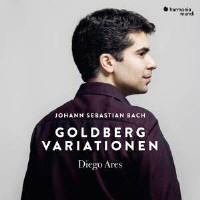Texte paru dans: / Appeared in: Harmonia Mundi |
|
|
Reviewer: Peter
Burwasser
Almost immediately upon
hearing this luminous, magisterial performance of Goldberg, I was struck by
the resemblance of Diego Ares’s playing to that of Richard Egarr, whose 2005
recording of the work remains at the pinnacle of a very crowded field of
performers. Two similarities are obvious; both play the music on a
harpsichord, rather than the much more commonly used piano, and both repeat
the aria and all of the variations (as directed in the Urtext score). It was
not very surprising, therefore, to discover, hidden in the artist’s flowery
notes, that Ares was actually a student of Egarr.
As is the case in Egarr’s 2004
Harmonia Mundi recording, Ares is generally less extreme in his tempo
choices compared to most modern piano renditions. Slower variations are not
too slow (I am always happy to hear the magnificent opening aria played at a
walking tempo, rather than an unidiomatic crawl, for example). There are no
mad dashes, à la Gould, which can be exciting, but are probably more a
function of modern technique than Bach’s original spirit. I also relished
the gentle rhythmic fluidity of this playing, in the manner of judiciously
applied rubato in Chopin. Of course, ultimately, these opinions are
subjective, since we do not have recordings from the 18th century, let alone
metronome markings. And yet, there is an emotional and aesthetic
completeness about the overall style of Ares’s playing that seems synched to
the composer’s vision. This perception would be far less likely without the
consistent application of repeats, which allows Ares to engage in subtle
shifts in the shape and construction of embellishments. In this sense, these
are not literally repeats, but rather enhancements. This doubling of the
scope of the work renders a timelessness, a vastness of beauty, that truly
allows a great performer, which Ares most certainly is, to create a world
for the listener to dwell in, alone with the majesty of Bach. Egarr’s recording will remain high on my list of great Bach recordings, and I will always be indebted to him for the revelation that he afforded me when I heard him perform Goldberg live in Seattle many years ago, and for that matter, I will still listen to the many great piano performan-ces, yes, including Gould’s. But Ares sets a new standard here. I slightly prefer the richer sound of his Joel Katzman harpsichord, which is a copy of a 1769 Pascal Taskin, to that of Egarr’s (also a Katzman, but based on an older instrument), and I find the newer recording to have a more vivid sound. This is now my desert island Goldberg. | |
|
|
|
|
|
|
|
Cliquez l'un ou l'autre
bouton pour découvrir bien d'autres critiques de CD |
|




